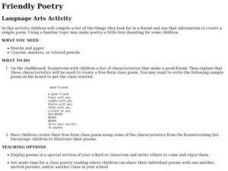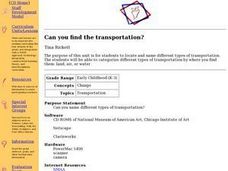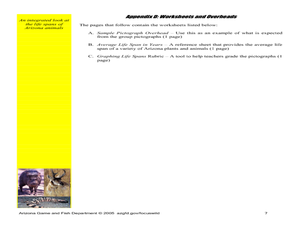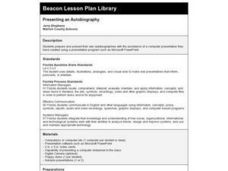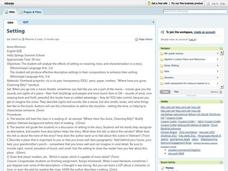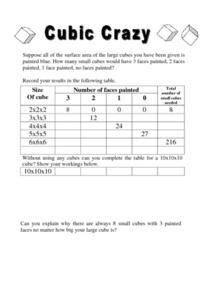Curated OER
Exploring the Families of Instruments
Students investigate the families of instruments. For this instrument lesson, students discuss how each instrument family makes their sound. Students then make their own instruments. Students write a paragraph about their favorite...
Curated OER
Propaganda/Stereotypes Used in the Media
Students write a character sketch on a television character who they feel is a stereotype. In this propaganda/stereotype instructional activity, students discuss the definition of the terms and ways that the media uses both. Students...
Curated OER
Curve Fitting and the TI-85 Calculator
Seventh graders follow a step-by-step guide for using graphing calculator to determine equations which best fit data graphed. They gather data from various sites on the web, or they do searches to find information necessary to complete...
Curated OER
Friendly Poetry
In this activity, students will compile a list of the things they look for in a friend and use that information to create a simple poem. Using a familiar topic may make poetry a little less daunting for some children.
Curated OER
Review Poetry and the Simile and the Metaphor
Learners compile a list of the things they look for in a friend. Then they use that information to create a simple poem. Later they illustrate and display their poems.
Curated OER
Creating My Personal Animal ABC Book
Students conduct Internet research on various animals. They write and create an Animal ABC book, including pictures of each animal, and each animal's phyla and class, to present to a young child.
Curated OER
Classifying Monocot And Dicot Plants
Sixth graders identify the parts of a flower, and tell the difference between monocots and dicots. They group plant by leaf types and characteristics placing the information in table form on the computer.
Curated OER
Can you find the transportation?
Students locate and name different types of transportation. They categorize types of transportation by where you find them: land, air, or water. Students graph the information collected. Additional ideas are listed for cross curriculum.
Curated OER
An Interdisciplinary Deer and Human Population Study
Students answer the question, "What environmental problems arise due to animal and human overpopulation and what might need to be done to combat these problems?" They play games, graph data and write proposals about the question.
Curated OER
Spedwards
Students discuss what makes up a community. Students elect officials of their community and complete an application for the position. Students research jobs within the community and hold a job fair where parents come to school and share...
Curated OER
Jellybean Graphs
Second graders predict and graph data based on the color of jelly beans they think are in a handful. In this prediction lesson plan, 2nd graders will predict how many of each color jellybean are in a handful. Then they graph these...
Curated OER
Charting Animal Life Spans
Second graders research animal life spans and complete related math activities. In this life span lesson, 2nd graders read How Many Candles and discuss life spans. Students arrange animal cards based on their life spans. Students find...
Curated OER
Metaphors in Literature
Eighth graders analyze literature and the use of metaphors. In this metaphors lesson, 8th graders view and discuss the examples of metaphors. Students complete the phrases by writing in a metaphor.
Curated OER
Hole Mole
Second graders read the book Hole Mole and complete activities that teach them about Mexican culture. In this Holy Mole lesson plan, 2nd graders complete cooking, drawing, writing, and other activities.
Curated OER
Make a Mockery of Magazines
Learners examine tabloids. In this journalism lesson, students compare and contrast satirical magazines and then plan, write, and compile their own.
Curated OER
Making a Water Filter
Fifth graders draw a plan that they think will clean the sludge in a jar. Students construct the treatment system they designed, take a bottle of sludge to the system and try it out, writing down what happened.
Curated OER
An Introduction to Collocation
Learners listen to text in the form of a letter and then read the same text to determine how collocations can have different meanings. Students listen to a sample of dialogue to understand how the the usages of "make," "do," and "have"...
Curated OER
Presenting an Autobiography
Students write and present their own autobiographies using a computer slideshow.
Curated OER
How Safe Is Your Backyard?
Seventh graders investigate the safety of soil and water locally and communicate via the Internet with students in different locales sharing information. They research the Internet using its multimedia capabilities and collate the data...
Curated OER
American Idols
Learners design a biographical web for a famous American figure. They identify key research questions and organize information as a prewriting strategy. This can be done individually or as a class, depending on your needs and students.
Curated OER
Setting And Plot
High schoolers investigate the concept of setting with the use of reading different excerpts from multiple samples of texts. They execute well-thought out statements of the setting considering the important details that point it out...
Curated OER
What Are Maps For?
Middle schoolers create a story about a problem someone could have which could be solved by the use of a map. They complete a worksheet that guides them through the features of a map of Chicago. Then they calculate story problems using...
Curated OER
Mixed Plate
Young scholars locate a sample restaurant review in a newspaper or magazine. They examine the review to find the opinion of the reviewer and discuss reviews that convey mixed opinions. They compose an original review in a similar style...
Curated OER
Copy the Alphabet-- Lower Case Letters
In this language arts activity, students learn to form examples of lower case letters of the alphabet. Students write each letter under the sample in an unlined oval.





